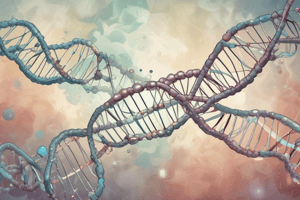Podcast
Questions and Answers
What role do base-stacking interactions play in the structure of DNA?
What role do base-stacking interactions play in the structure of DNA?
- They enable the repair of genetic mutations in nucleic acids.
- They stabilize the DNA double helix by aligning bases parallel to each other. (correct)
- They facilitate the binding of RNA during transcription.
- They cause the DNA strands to unwind during replication.
Which enzyme is responsible for unwinding the DNA double helix during replication?
Which enzyme is responsible for unwinding the DNA double helix during replication?
- RNA polymerase
- DNA helicase (correct)
- DNA polymerase
- Ligase
What happens to the bases of DNA strands during the unwinding process?
What happens to the bases of DNA strands during the unwinding process?
- They are exchanged with RNA bases.
- They are no longer connected by hydrogen bonds and can pair with free nucleotides. (correct)
- They form new hydrogen bonds with ribosomes.
- They become hydrophilic and dissolve in the nucleus.
What is the function of hydrophobic interactions among purine and pyrimidine bases in DNA?
What is the function of hydrophobic interactions among purine and pyrimidine bases in DNA?
The replication fork refers to which part of the DNA replication process?
The replication fork refers to which part of the DNA replication process?
What type of structure is present in the DNA model described?
What type of structure is present in the DNA model described?
What defines the directionality of a DNA single strand?
What defines the directionality of a DNA single strand?
How many hydrogen bonds are formed between adenine and thymine in DNA?
How many hydrogen bonds are formed between adenine and thymine in DNA?
Which of the following base pairs has the strongest hydrogen bonding interaction?
Which of the following base pairs has the strongest hydrogen bonding interaction?
What occurs to the strands of DNA during replication?
What occurs to the strands of DNA during replication?
Which of the following statements about complementary bases in DNA is accurate?
Which of the following statements about complementary bases in DNA is accurate?
What factor contributes to the stability of the DNA double helix structure?
What factor contributes to the stability of the DNA double helix structure?
What is the result of reversing the order of bases in a 3’ to 5’ sequence?
What is the result of reversing the order of bases in a 3’ to 5’ sequence?
What is the primary function of deoxyribonucleic acid (DNA)?
What is the primary function of deoxyribonucleic acid (DNA)?
Which nitrogen-containing bases are found in DNA?
Which nitrogen-containing bases are found in DNA?
What component distinguishes deoxyribonucleic acid (DNA) from ribonucleic acid (RNA)?
What component distinguishes deoxyribonucleic acid (DNA) from ribonucleic acid (RNA)?
Which of the following processes does NOT involve nucleic acids?
Which of the following processes does NOT involve nucleic acids?
During cell division, what happens to the genetic information stored in DNA?
During cell division, what happens to the genetic information stored in DNA?
Which type of mutation results in a change in a single nucleotide in the DNA sequence?
Which type of mutation results in a change in a single nucleotide in the DNA sequence?
Which of the following nucleotides is a pyrimidine base found in nucleic acids?
Which of the following nucleotides is a pyrimidine base found in nucleic acids?
What role does uracil play in nucleic acids?
What role does uracil play in nucleic acids?
Flashcards
Base Stacking Interactions
Base Stacking Interactions
Interactions within a DNA double helix where the base planes are parallel, like a stack of coins.
DNA Double Helix Stabilization
DNA Double Helix Stabilization
Base stacking and other interactions help hold the DNA double helix together.
Replication Fork
Replication Fork
The point where the DNA unwinds during replication. It's constantly shifting.
DNA Helicase
DNA Helicase
Signup and view all the flashcards
Hydrogen Bonds
Hydrogen Bonds
Signup and view all the flashcards
Nucleic Acid
Nucleic Acid
Signup and view all the flashcards
Friedrich Miescher
Friedrich Miescher
Signup and view all the flashcards
Nitrogen-Containing Bases
Nitrogen-Containing Bases
Signup and view all the flashcards
Deoxyribonucleic Acid (DNA)
Deoxyribonucleic Acid (DNA)
Signup and view all the flashcards
DNA Function
DNA Function
Signup and view all the flashcards
Purine Bases
Purine Bases
Signup and view all the flashcards
Pyrimidine Bases
Pyrimidine Bases
Signup and view all the flashcards
Thymine
Thymine
Signup and view all the flashcards
DNA Base Pairing
DNA Base Pairing
Signup and view all the flashcards
Complementary Bases
Complementary Bases
Signup and view all the flashcards
Hydrogen Bonds in DNA
Hydrogen Bonds in DNA
Signup and view all the flashcards
DNA Structure
DNA Structure
Signup and view all the flashcards
Antiparallel Strands
Antiparallel Strands
Signup and view all the flashcards
Base Pairing Rules
Base Pairing Rules
Signup and view all the flashcards
Base order and direction
Base order and direction
Signup and view all the flashcards
DNA Stability
DNA Stability
Signup and view all the flashcards
Study Notes
Nucleic Acids Reviewer Finals
- This document is a study guide for a final exam on nucleic acids, specifically for BS Medical Laboratory Science students at Holy Angel University.
- The document provides a detailed overview of nucleic acids, including their structure, function, and types.
Studying That Suits You
Use AI to generate personalized quizzes and flashcards to suit your learning preferences.



